Expired contract of Eureka Union Teachers Association advances to state
Teachers from the EUTA protest for a fair contract in front of the Eureka Union School District Office
On Nov. 8, contract negotiations between the Eureka Union Teachers Association (EUTA) and the Eureka Union School District (EUSD) will be taken to the state level for resolution.
Teachers in EUSD have been working under an expired contract since July 1.
EUSD and EUTA began negotiations regarding teachers’ salaries and benefits on May 25 and since have met five times, unable to come to a resolution.
If negotiations continue to be unsuccessful, it is possible teachers will strike. An informal tally of teachers willing to strike has been taken.
“I have never seen a vote this overwhelming to take a one day strike,” Kelly Lewis, a teacher at Olympus Junior High said. In the event of a strike, schools may be unable to function because of the statewide substitute teacher shortage.
“The last thing we want to do is anything that takes even a single day of education away from our kids,” said Gina Willis, lead negotiator for EUTA and teacher at Olympus Junior High. “We are their teachers. We have their educational best interests at heart. … We’re trying to keep it as far away from the kids as possible. That’s the primary reason why (striking is) a last resort…But the district is moving us in that direction when they don’t show us real intent to bring that salary up.”
EUSD consists of seven elementary and junior high schools. Teachers are working under an expired contract that offers less pay than the
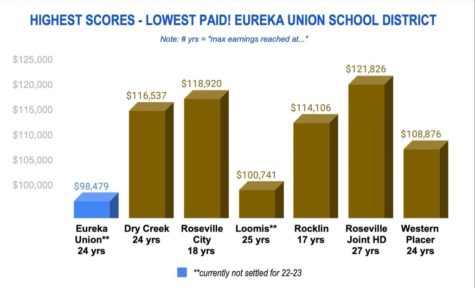
in neighboring elementary and junior high school districts that feed into Roseville Joint Union High School District. Top-earning teachers who have taught for 24 or more years in EUSD receive yearly salaries of $98,479, while top-earning teachers make $118,920 in Roseville City School District and $116,537 in Dry Creek Joint Elementary School District.
EUSD Board President and spokesperson Renee Nash is focused on the practicality of the budget that would bring about the raises the teachers ask for.
“There are some districts in the area that do pay more than our district. And that’s because they can afford to pay more. The funding from the state is not equal from school district to school district. It depends on a number of factors, most significantly, the makeup of your student population. (The teachers) want more than we can afford to pay,” Nash said.
Willis suggests that the funding for higher salaries could come from the district reserves or from the ongoing payments the district receives from the state. She explained that 13.26% of the money the district receives is in the form of “ongoing funds,” meaning this is money the district is receiving consistently, which is available for compensating its employees.
EUSD’s reserve is estimated between 32% and 44%. Willis said the state requires 3% of funding to be allocated to the district reserve, but 10% is widely recommended. 20% is common.
“(It) makes them look like a savings account,” Willis said.
Nash asserts that the reserve budget is justified, and that it would be fiscally irresponsible to allocate the money in the reserve to ongoing expenses such as teacher salaries.
“You cannot use reserves to pay for ongoing expenses because reserves are by definition one-time dollars. The district has a significant amount of work that needs to be done on our facilities and we will be making a number of very expensive textbook adoptions over the next few years so I do not believe that there is any significant amount of money in the reserves to cover wage increases nor do I believe it is responsible to cover ongoing expenses with one time dollars,” Nash said.
During a recent protest outside the district office, teachers held signs bearing slogans such as “Highest Test Scores, Lowest Pay,” “I Don’t Want to Strike, But I Will” and “Supporting Teachers is Supporting Students.”
Shawna Lukasko, a teacher at Excelsior Elementary, said while protesting, “We’re more united as teachers but we’re more divided from the district than we ever have been.”
“They’re free to protest. I’m a huge supporter of the First Amendment. I have no problems with the activity that they’re engaging in. The reality is (that) we put an offer on the table that I think represents what our district can afford to pay,” Nash said.
Many of the teachers have put barcodes on their cars that are linked to a slide show summarizing the pay disparity and explaining what the teachers are protesting for because they are prohibited from sending clarifying information to parents using their school email. To get the word out, they have resorted to sending fliers home to parents and wearing t-shirts advocating for their cause.
“A Roseville City teacher two miles away from me who has been teaching the same exact years as me is making $20,000 more than me,” a Maidu Elementary teacher who wished to remain anonymous said.
Another point of contention within the negotiations is the medical benefits provided for teachers. Willis says that of the approximate 80% of teachers who participate in the district’s health care benefit plan, about 35% are taking $1,000 or more out of their own paychecks every month to support their own health benefits outside the district-provided plan.
When given the choice between increased medical benefits or higher salaries, teachers have historically chosen higher salaries to benefit the greatest number of people as not all teachers partake in the medical benefit package the district offers. However, the teachers are petitioning for both higher salaries and increased medical benefits.
“We shouldn’t have to pick one or the other,” Willis said.
Currently, both their salaries and their medical benefits are the lowest of any neighboring middle or elementary school districts.
Community members who wish to learn more or let their opinions be heard by elected officials can attend the next board meeting on November 14 at the EUSD office. The meeting is open to the public, and time is allocated for public comment.
Corrections: Previously misstated top earners at Dry Creek School District made $115,907; they make $116,537. Previously misstated top earners at Roseville City School district made $107,198; they make $118,920.




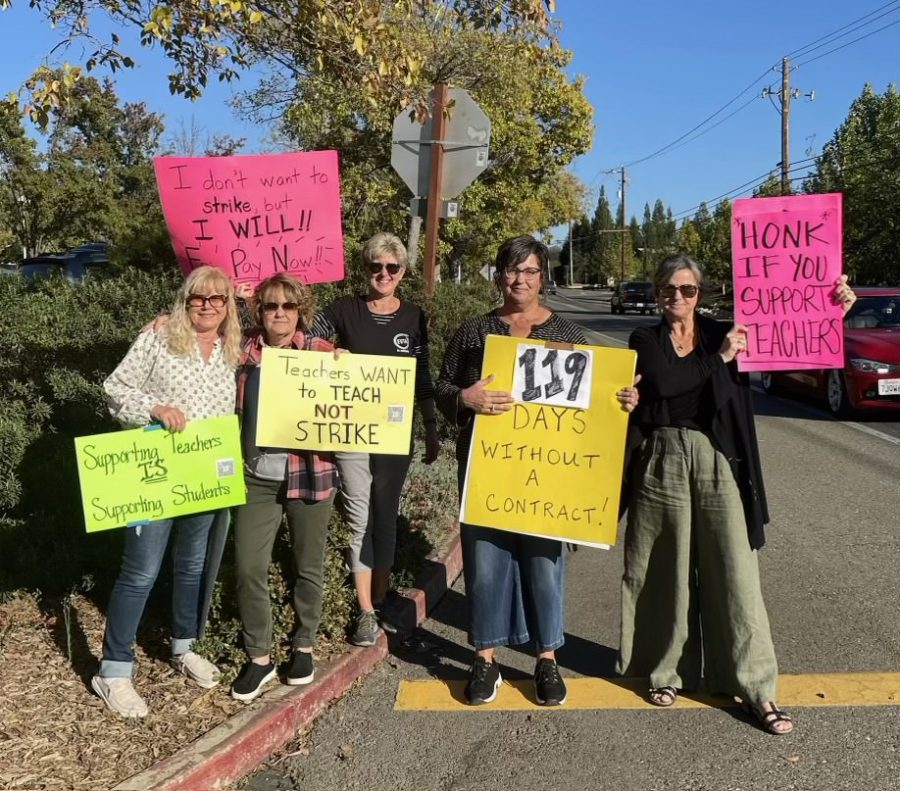

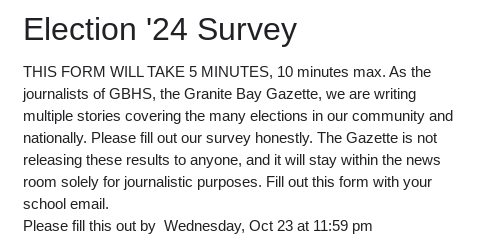

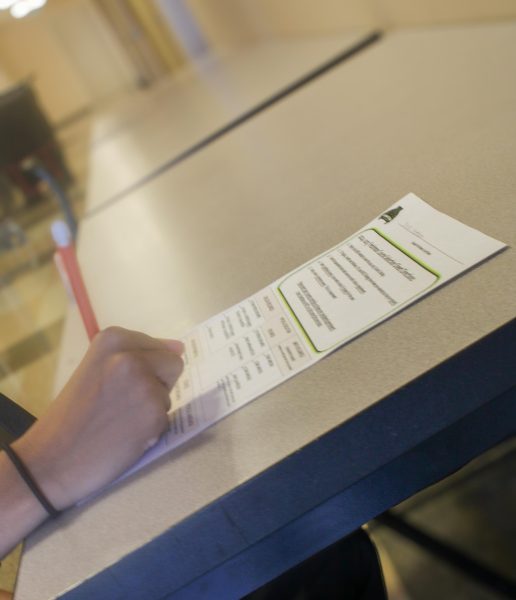
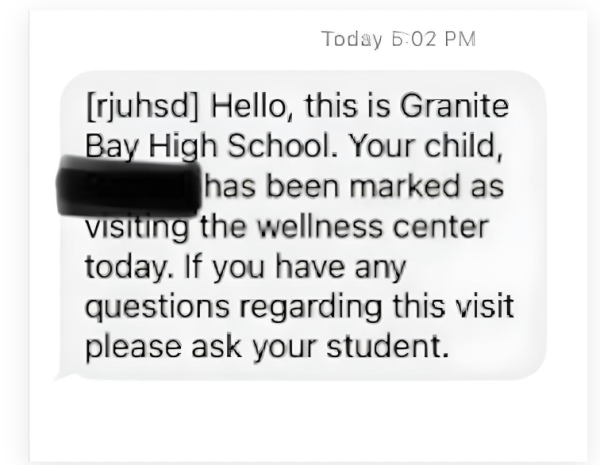






Ava • Feb 17, 2023 at 10:49 am
Having gone through this school district and finally seeing the huge gap in pay they have is very sad. However, throughout my years of being there I had seen many posters about going on strike and I’m glad it’s finally being noticed more.
sofia • Nov 14, 2022 at 3:17 pm
This is a very well written story good job Riley!
Taylor Langford-Wilson • Nov 5, 2022 at 6:02 pm
Very well written article. Go teachers go! TAKE THAT STRIKE!!! TAKE BACK THE POWER
Taylor Langford-Wilson • Nov 5, 2022 at 6:05 pm
I went through the EUSD from kindergarten to 8th grade. every year you could be in the district. I was nothing but disappointed by the way they handled bullying along with many other things
Lauren • Nov 4, 2022 at 10:51 am
I agree that teachers should be paid more due to prices increasing. They should also have full coverage on heath insurance.
Mitra • Nov 4, 2022 at 10:49 am
Its awful that they have been working for barely anything compared to other districts teachers. They should have gone on strike sooner.
Sofiya Khartchenko • Nov 4, 2022 at 10:45 am
The difference in pay between EUSD and the districts in the surrounding area is almost ridiculous. In middle school, my teachers went on strike for over a month and the pay they received before the strike was even higher than what the teachers in EUSD are making now.
Addison Revelli • Nov 4, 2022 at 10:45 am
Seeing both sides of the story, it makes sense why the teachers are upset but also why there is a pay gap. I hope that somehow they can get more funding to be able to pay the teachers more because they clearly care a lot about the students since they are so hesitant to go on strike.
Anonymous • Nov 4, 2022 at 8:57 am
I wounder what expensive changes there making
Caleb • Nov 4, 2022 at 8:50 am
It’s crazy to see the pay gap they’ve been working under for so long.
anonymous • Nov 4, 2022 at 8:47 am
what are the arguments from the teachers, compared to the arguments of the district?
Videhi Shelat • Nov 4, 2022 at 8:47 am
I think it’s really awesome that one of the biggest reasons these teachers have not gone on strike yet is for the benefit of their students. It’s also really sad to look at the statistics where you see that EUSD has the lowest teacher salary out of all of the surrounding districts and the difference can be up to $20,000.
Allison • Nov 4, 2022 at 8:45 am
I was at Olympus last year, and I remember seeing cars with the posters talking about a strike in the back of the teachers’ cars. It’s interesting but also unfortunate to see that EUSD is one of the school districts that pay their staff the lowest and that someone who works at Roseville city makes $20,000 more than them. If the district can’t pay very much more, why can’t they?
jordan • Nov 4, 2022 at 8:45 am
I don’t think i know enough information about this to share an opinion but i saw these protesters yesterday and i was very curious what, other than them protesting higher salary, was going on entirely. This article helped me understand a little more of that and allowed me to compare their salary to other districts and other schools.
Jaena • Nov 4, 2022 at 8:44 am
I’m glad to see that this is getting more attention, as many of my teachers in the past have felt very strongly about this issue. I hope they resolve this in a way beneficial to the teachers.
Suri • Nov 4, 2022 at 8:44 am
If the district doesn’t have money to pay teachers, how will they solve the strike? For teachers in other districts to make $20,000 more than the teachers at EUSD is unfair, but the budget the district has from the state depends on the student population. Until the district has more money to spend, the conflict cannot be resolved.
Kenneth DeVault • Nov 4, 2022 at 8:42 am
I agree teachers should be paid more that are a part of the Eureka Union district because of inflation in gas prices ,groceries, taxes, etc.
jacklyn • Nov 4, 2022 at 8:40 am
its nice that the teachers are untied together still even though they’re faced with a challenge